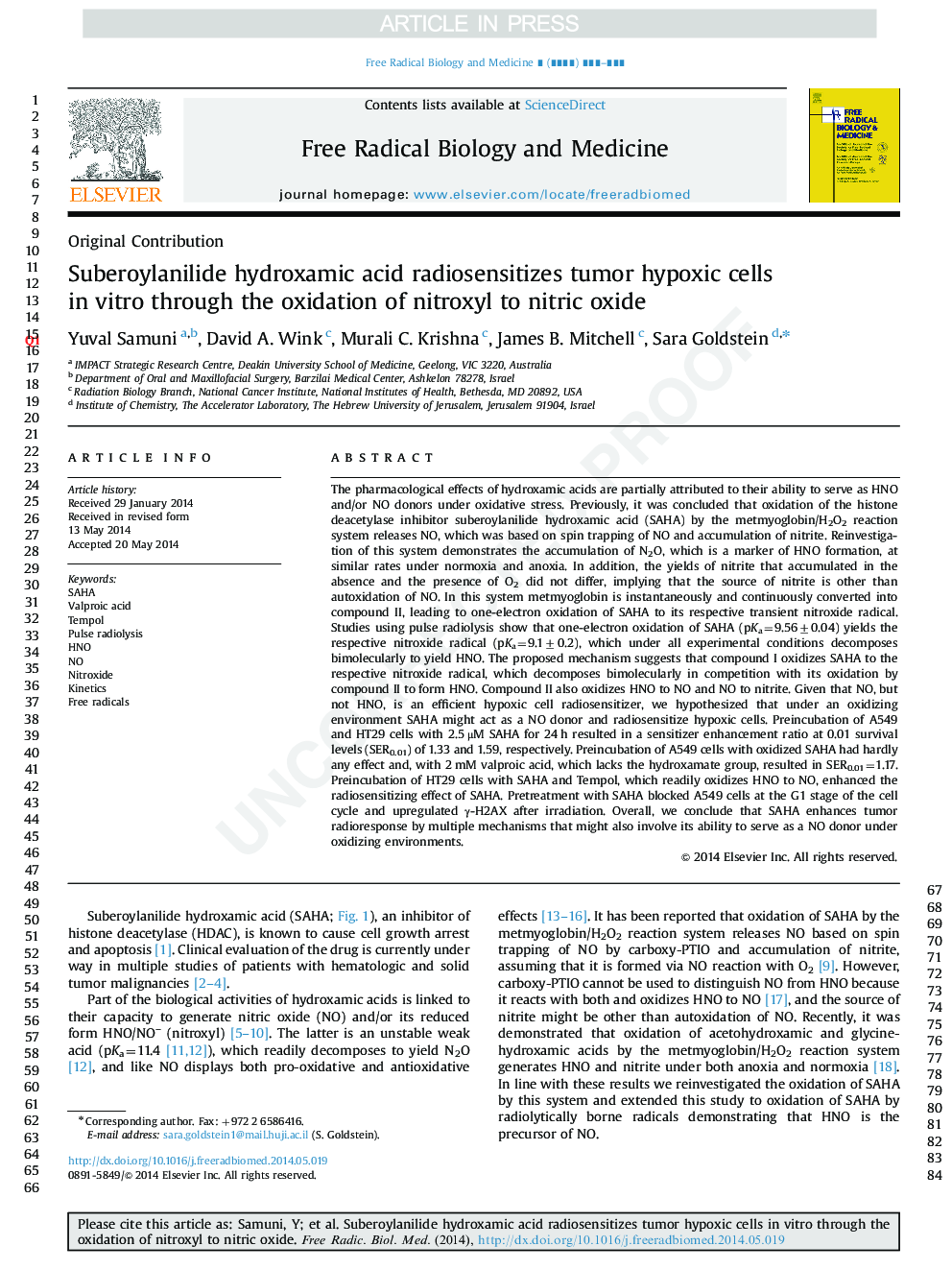| کد مقاله | کد نشریه | سال انتشار | مقاله انگلیسی | نسخه تمام متن |
|---|---|---|---|---|
| 8270351 | 1534969 | 2014 | 8 صفحه PDF | دانلود رایگان |
عنوان انگلیسی مقاله ISI
Suberoylanilide hydroxamic acid radiosensitizes tumor hypoxic cells in vitro through the oxidation of nitroxyl to nitric oxide
دانلود مقاله + سفارش ترجمه
دانلود مقاله ISI انگلیسی
رایگان برای ایرانیان
کلمات کلیدی
موضوعات مرتبط
علوم زیستی و بیوفناوری
بیوشیمی، ژنتیک و زیست شناسی مولکولی
سالمندی
پیش نمایش صفحه اول مقاله

چکیده انگلیسی
The pharmacological effects of hydroxamic acids are partially attributed to their ability to serve as HNO and/or NO donors under oxidative stress. Previously, it was concluded that oxidation of the histone deacetylase inhibitor suberoylanilide hydroxamic acid (SAHA) by the metmyoglobin/H2O2 reaction system releases NO, which was based on spin trapping of NO and accumulation of nitrite. Reinvestigation of this system demonstrates the accumulation of N2O, which is a marker of HNO formation, at similar rates under normoxia and anoxia. In addition, the yields of nitrite that accumulated in the absence and the presence of O2 did not differ, implying that the source of nitrite is other than autoxidation of NO. In this system metmyoglobin is instantaneously and continuously converted into compound II, leading to one-electron oxidation of SAHA to its respective transient nitroxide radical. Studies using pulse radiolysis show that one-electron oxidation of SAHA (pKa=9.56±0.04) yields the respective nitroxide radical (pKa=9.1±0.2), which under all experimental conditions decomposes bimolecularly to yield HNO. The proposed mechanism suggests that compound I oxidizes SAHA to the respective nitroxide radical, which decomposes bimolecularly in competition with its oxidation by compound II to form HNO. Compound II also oxidizes HNO to NO and NO to nitrite. Given that NO, but not HNO, is an efficient hypoxic cell radiosensitizer, we hypothesized that under an oxidizing environment SAHA might act as a NO donor and radiosensitize hypoxic cells. Preincubation of A549 and HT29 cells with 2.5 μM SAHA for 24 h resulted in a sensitizer enhancement ratio at 0.01 survival levels (SER0.01) of 1.33 and 1.59, respectively. Preincubation of A549 cells with oxidized SAHA had hardly any effect and, with 2 mM valproic acid, which lacks the hydroxamate group, resulted in SER0.01=1.17. Preincubation of HT29 cells with SAHA and Tempol, which readily oxidizes HNO to NO, enhanced the radiosensitizing effect of SAHA. Pretreatment with SAHA blocked A549 cells at the G1 stage of the cell cycle and upregulated γ-H2AX after irradiation. Overall, we conclude that SAHA enhances tumor radioresponse by multiple mechanisms that might also involve its ability to serve as a NO donor under oxidizing environments.
ناشر
Database: Elsevier - ScienceDirect (ساینس دایرکت)
Journal: Free Radical Biology and Medicine - Volume 73, August 2014, Pages 291-298
Journal: Free Radical Biology and Medicine - Volume 73, August 2014, Pages 291-298
نویسندگان
Yuval Samuni, David A. Wink, Murali C. Krishna, James B. Mitchell, Sara Goldstein,